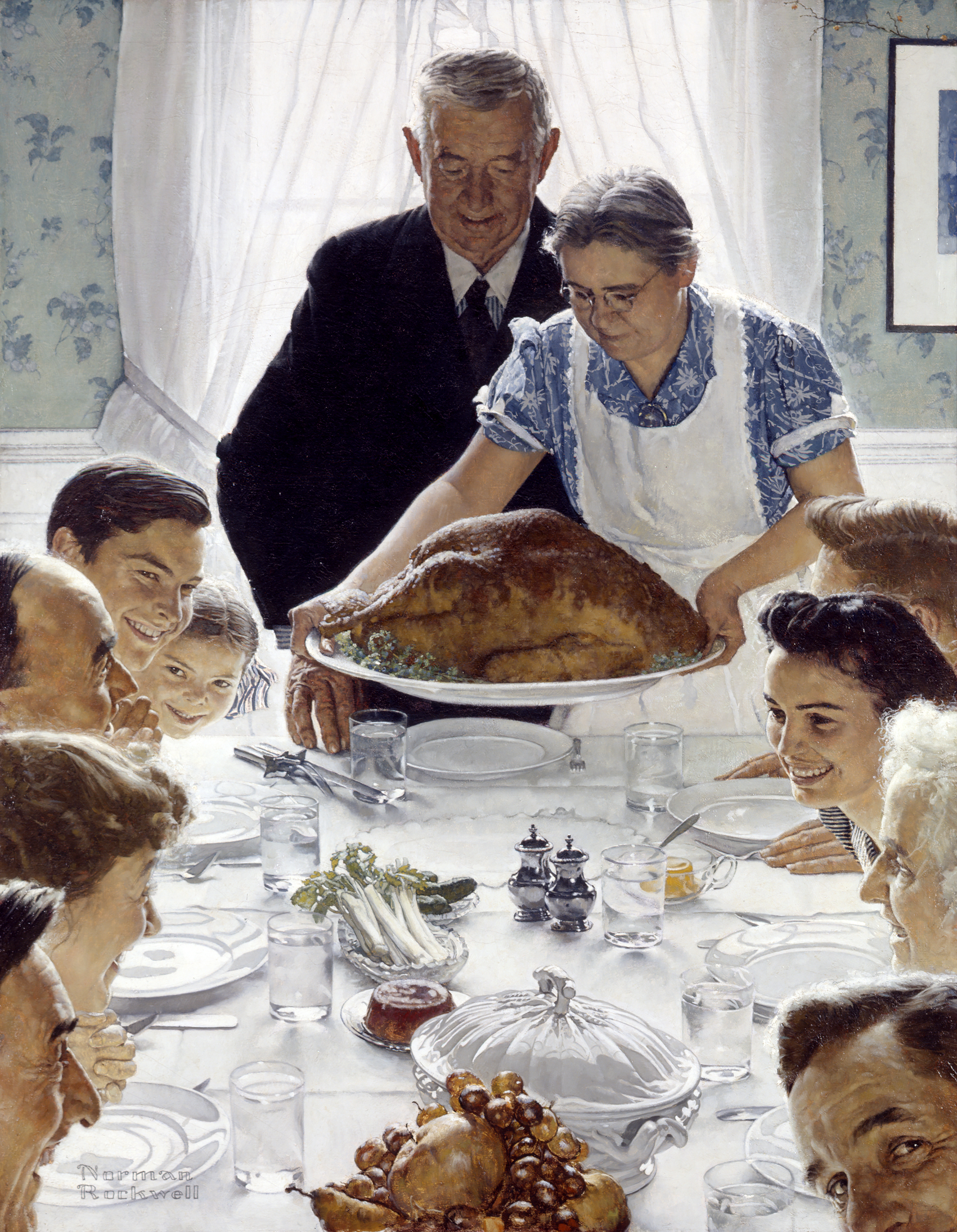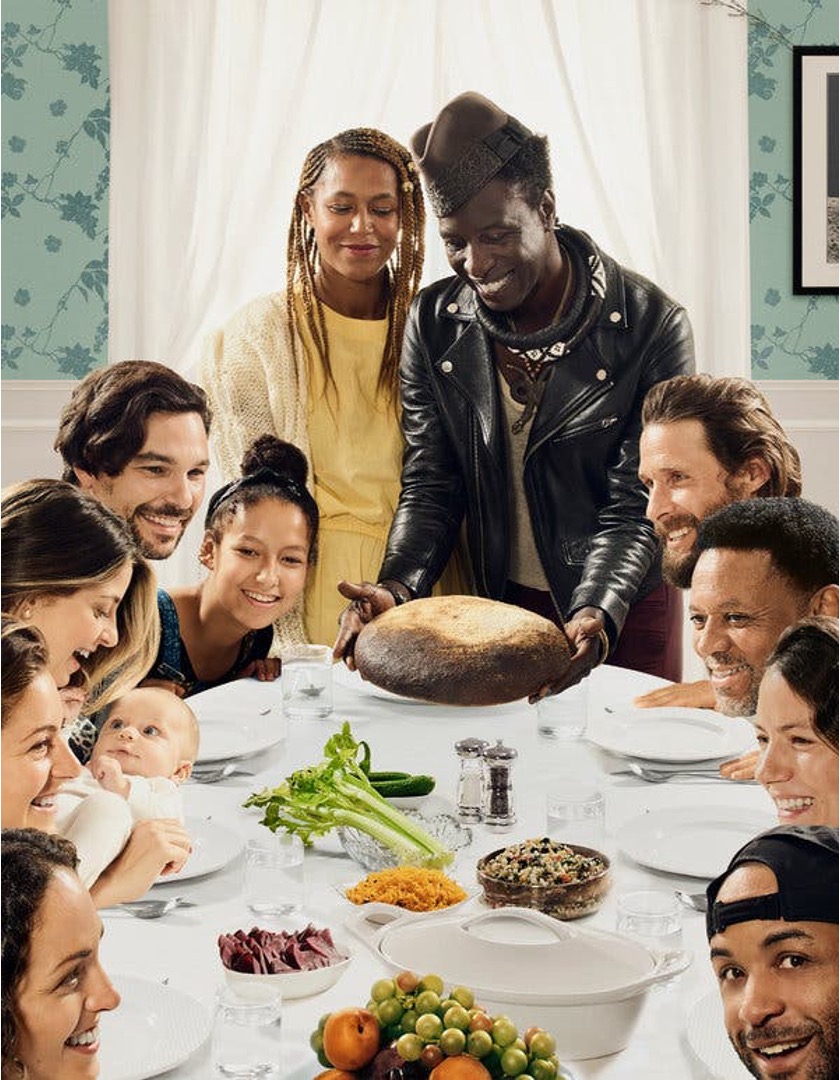Quick Pics: Freedom From Want - Week of 11/23/2020
Freedom from Want, (1943)
Introduction:
Freedom from Want is one of four images Norman Rockwell created named the Four Freedoms. He created it in 1943 for Americans to think about having enough to eat as an American ideal worth fighting for. The image also conveys the comfort that goes with eating around a table of loved ones. Looking at this image, Americans were about to visualize what we were fighting for in World War II. Since 1943 many other artists have recreated the image to tell this story in their way and based on their experiences.
Notice and Wonder:
- What foods do you see?
- Describe the people at the table.
- What is the feeling you have when you look at this image? Are the people happy to be together?
- Do you think the man in the bottom left corner might be inviting you to pull up a seat at the table?
- Some people think it is surprising that the woman holding the turkey seems to be having an easy time carrying what appears to be a heavy turkey. What do you think?
- What is the feeling?
Fun Facts:
The image has become a model for the all-American Traditional Thanksgiving. Its composition is familiar to many, and has made its way into the public consciousness. The image features the artist’s neighbors and family members, who posed in his studio at individual sessions. Featured is Mrs. Thadeus Wheaton, the family’s cook, who holds the large turkey, as well as the artist’s wife Mary Barstow Rockwell (second from bottom left) and Nancy Hill Rockwell, his mother (second from bottom right). The work reflects Rockwell’s mastery of visual texture in art, from the gleam of white china to the transparency of water in glasses. Despite Rockwell’s artistic optimism, he had misgivings about depicting the bounty of the holiday when much of Europe was “starving, overrun [and] displaced” during World War II. In letters to Rockwell, the public commented upon the abundance of food, but also the importance of community, connection and joy.
In 2012, Hank Willis Thomas saw a poster of Norman Rockwell’s painting of a family seated around a holiday table, the matriarch presenting a turkey to her guests. For Mr. Thomas, a 42-year-old black artist raised in Manhattan, the pale complexions in Mr. Rockwell’s 1943 masterpiece did little to represent his experience of a diverse America. So he decided to create a tableau of his own. Many artists have used Norman Rockwell’s Freedom of Want as inspiration for creating their own images which tell their stories of family, Thanksgiving and connectedness.
What you can do:
Notice traditions in your family. What stays the same, what changes? Compare Norman Rockwell’s Freedom from Want with another version. What is the same and what is different? What would your Freedom from Want look like? Draw it!
Image Resources
Freedom From Want (1943)
Freedom From Want (2012)
Freedom From Want (2018)
Image Credits:
From From Want, 1943
Norman Rockwell (1894 - 1978)
Oil on canvas
Story Illustration for The Saturday Evening Post, March 6, 1943
© 1943 SEPS Curtis Licensing, Indianapolis, IN.
From From Want, 2012
Hank Willis Thomas and Emily Shur
Photograph
Photo published in the New York Times, 2018
© 2012 Hank Willis Thomas
From From Want, 2018
Roz Chast
Ink and Watercolor on Paper
Cover illustration for The New Yorker, November 26, 2018
© 2018 Roz Chast
- Grade
- K-6
- Theme
- Quick Pics
- Length
- Each Quick Pic activity is about 5-10 minutes in duration, with each being taught one image per day over a week.
- Discipline
- Social Studies, Language Arts: Speaking and Listening, Art
- Vocabulary
- food, family, thankfulness, together, hunger
Standards
This curriculum meets the standards listed below. Look for more details on these standards please visit: ELA and Math Standards, Social Studies Standards, Visual Arts Standards.
- CCSS.ELA-Literacy.CCRA.L.1
- Demonstrate command of the conventions of standard English grammar and usage when writing or speaking.
- CCSS.ELA-Literacy.CCRA.L.2
- Demonstrate command of the conventions of standard English capitalization, punctuation, and spelling when writing.
- CCSS.ELA-Literacy.CCRA.L.3
- Apply knowledge of language to understand how language functions in different contexts, to make effective choices for meaning or style, and to comprehend more fully when reading or listening.
- CCSS.ELA-Literacy.CCRA.L.4
- Determine or clarify the meaning of unknown and multiple-meaning words and phrases by using context clues, analyzing meaningful word parts, and consulting general and specialized reference materials, as appropriate.
- CCSS.ELA-Literacy.CCRA.L.5
- Demonstrate understanding of figurative language, word relationships, and nuances in word meanings.
- CCSS.ELA-Literacy.CCRA.L.6
- Acquire and use accurately a range of general academic and domain-specific words and phrases sufficient for reading, writing, speaking, and listening at the college and career readiness level; demonstrate independence in gathering vocabulary knowledge when encountering an unknown term important to comprehension or expression.
- CCSS.ELA-Literacy.CCRA.SL.1
- Prepare for and participate effectively in a range of conversations and collaborations with diverse partners, building on others' ideas and expressing their own clearly and persuasively.
- CCSS.ELA-Literacy.CCRA.SL.2
- Integrate and evaluate information presented in diverse media and formats, including visually, quantitatively, and orally.
- CCSS.ELA-Literacy.CCRA.SL.3
- Evaluate a speaker's point of view, reasoning, and use of evidence and rhetoric.
- CCSS.ELA-Literacy.CCRA.SL.4
- Present information, findings, and supporting evidence such that listeners can follow the line of reasoning and the organization, development, and style are appropriate to task, purpose, and audience.
- CCSS.ELA-Literacy.CCRA.SL.5
- Make strategic use of digital media and visual displays of data to express information and enhance understanding of presentations.
- CCSS.ELA-Literacy.CCRA.SL.6
- Adapt speech to a variety of contexts and communicative tasks, demonstrating command of formal English when indicated or appropriate.


